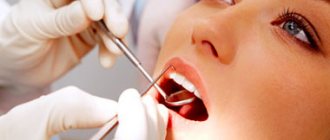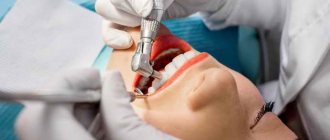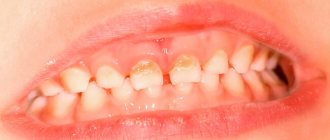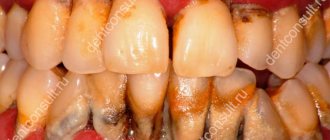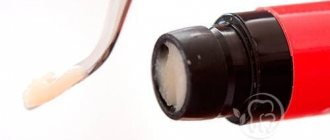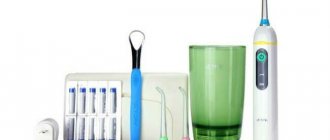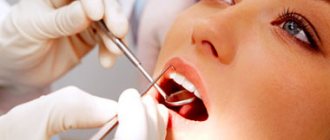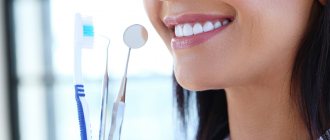Green-Vermilion method
It is based on a quantitative study of tartar and plaque. The hygienic condition is assessed according to the following scale:
- 0 – no plaque;
- 1 – up to 1/3 of the surface of the visible part (crown) of the tooth is covered with plaque;
- 2 – plaque covers no more than 2/3 of the crown surface;
- 3 – more than 2/3 of the tooth crown is covered with plaque.
To detect plaque, the surface of the visible part of the tooth is painted with one of the special substances:
- 3-5 percent alcohol tincture of iodine;
- eosin;
- Lugol's solution.
In addition, a special tablet is used, which the patient must keep in the mouth for some time, after which the plaque turns pink. This method is often used at home for the patient to independently assess the amount of plaque. A specialist detects dental calculus without the use of dyes. The scale coincides with that for plaque.
The specialist gives a general assessment of the hygienic condition of the oral cavity based on the characteristics of the so-called “Ramfjord teeth”. The buccal surfaces of 6 specific teeth on the upper jaw and the lingual surfaces on the lower jaw are examined, since it is in these areas that the excretory ducts of the salivary glands are located.
In digital form, the level of oral hygiene is the result of dividing the sum of indicators in the area of all teeth by 6. If any of the examined teeth is removed, the specialist is limited to a smaller number or characterizes plaque on neighboring teeth of the same group (molars, premolars, incisors) .
The assessment method described above was improved by Quigley and Hein (1962). They replaced the 3-point score with a 5-point score, focusing special attention on a more detailed study of the amount of plaque in the range from 0 to 1 on the Green-Vermilion scale. Despite the fact that changes were made to more accurately assess the effect of various hygiene products, periodontists widely use the technique, since the amount of plaque in the area where the gums adjoin the tooth is of particular importance for the development of inflammation.
Up to contents
Tartar Index
The Tartar Index identifies calculus deposits above and below the gums of the incisors or mandibular canines.
Tartar Index
Each surface is given points ranging from zero to three:
- Mouth rinse for gum inflammation
- 0 – absence of stone deposits;
- 1 – deposits up to 0.5 mm;
- 2 – deposits up to 1 mm;
- 3 – stone with a thickness of 1 mm and above.
Silness-Lohe method
In periodontics, preference is often given to the Silness-Lohe technique, which is based on determining the amount of soft plaque in the gingival zone. The essence of the method is simple: the dentist runs the end of the probe along the neck of the tooth, capturing the gingival groove. If the instrument does not capture plaque at all, a score of 0 is given. If the amount of plaque is small - 1. If a thin layer of plaque is noticeable near the neck of the tooth, and a significant amount is retained on the probe - 2. If a large amount of plaque and food is visually determined in the area where the gum adjoins the tooth. residues - Z. The indicators of all teeth are added up, the result is divided by the number of teeth.
Up to contents
The information in this article is for reference only and does not replace professional advice from a doctor. To make a diagnosis and prescribe treatment, consult a qualified specialist.
RMA
PMA is the papillary-marginal-alveolar index. It allows you to reliably assess the clinical picture of gingivitis. There are many different versions of these indexes, but Parma is the most commonly used. The total number of teeth is calculated based on age: from 6 to 11 years – 24 teeth, from 12 to 14 years – 28 teeth, from 15 years – 30 teeth. When there are no lesions, the PMA index is zero.
RMA Index
Classification and types of CPU
The amount of damage to teeth by the carious process is expressed by the KPU index. This abbreviation stands for:
- K – total number of teeth with caries;
- P – number of sealed elements;
- Y is the number of units removed.
The sum of these three indicators determines the dynamics and speed of the carious phenomenon.
There are 3 types of CPU:
- teeth (otherwise KPUz) – the number of filled and carious units in a person;
- all surfaces (or KPUps) – the number of dental surfaces infected with caries;
- cavities (i.e. KPUpol) – the number of carious and filled cavities.
For milk units, other decodings are used:
- KPz – the number of treated and carious elements;
- Kppov – number of affected dental surfaces;
- Kppol – number of fillings and cavities.
In children, elements in the primary occlusion that are removed or lost during physiological changes are not taken into account.
They use 2 types of indices simultaneously: KPU and KP. To determine the intensity of the pathology, both of these indicators are summed up.
If the CPU is within the limit:
- from 6 to 10 – the speed and intensity of caries is high;
- 3-5 – moderate;
- up to 2 – low.
These indicators do not reveal an objective picture of the state of oral health, since they have the following negative aspects:
Simultaneously treated and removed units are taken into account. Show the past picture of the disease and increase with a person’s age. The initial stage of the pathological process is not taken into account.
The prevalence of the pathological process is expressed as a percentage. A certain number of individuals with different manifestations of the disease (with the exception of focal demineralization) is taken, divided by the total number examined in this group, and multiplied by 100.
When comparing the prevalence of the disease by region, a scheme is used based on the assessment criteria of the multiplicity of cases among 11-13 year old children:
| Index | Level |
| no more than 30% | isolated |
| up to 80% | average |
| over 80% | high |
To find out the dynamics and speed of caries, dentists rely on the following indices:
- KPU (P) – surfaces sealed and affected by pathology;
- KPU (Z) – elements sealed and affected by disease.
To track this process in adult patients, slightly different criteria are used:
- KPU (P) – treated and carious surfaces;
- KPU (Z) – cured, carious and removed elements.
Important! When calculating the result, carious lesions that look like pigment spots are not taken into account. To calculate the average for a group, you need to determine the total value of individual indicators and divide them by the number of people surveyed
To calculate the average for a group, it is necessary to determine the total value of individual indicators and divide them by the number of people surveyed.
How effective is teeth whitening varnish, judging by reviews from experts and users.
Read here about how to quickly whiten your teeth at home.
At this address https://www.vash-dentist.ru/krasota-i-uxod/otbelivanie/maslo-chaynogo-dereva-dlya-domashnego-zubov.html you will find out whether there is any harm from the method of teeth whitening with tea tree oil.
12.4. Determination of gingival index - gi (Loe, Silness, 1963)
Intended to determine the location and severity of gingivitis. Used for clinical and epidemiological studies.
Each tooth is examined in four areas:
- gingival papilla from the medial and distal surfaces of the tooth;
- marginal gums from the vestibular and lingual surfaces of the tooth.
To determine bleeding, the gums are probed with a blunt instrument.
Codes Criteria
0 - Normal gum.
1 - Mild inflammation, slight discoloration, slight swelling, no bleeding on probing.
2 - Moderate inflammation, redness, swelling, bleeding on probing.
3 - Severe inflammation with noticeable redness and swelling, ulceration, and a tendency to spontaneous bleeding.
The gums are examined in all teeth or selectively by segments, sextants. Key teeth are 16, 21, 24, 36, 41, 44. The GI value for a site is determined by summing the codes around the examined tooth. The sum of the site codes divided by 4 indicates the GI of the tooth. To obtain the GI values of an individual examined, all GI values of the teeth must be summed and divided by the number of teeth examined.
Formulas for calculating the index:
| GI tooth = | ∑ points |
| 4 |
Interpretation:
0.1-1.0 - mild gingivitis;
1.1–2.0-moderate gingivitis;
2.1 – 3.0 — severe gingivitis;
| Individual's GI = | G.I. teeth |
| n teeth |
Inspection and subsequent calculation of the index require certain knowledge and manual skills. GI is the most accurate in assessing the effectiveness of the anti-inflammatory effects of drugs.
CPU in dentistry
Dentists should use these calculations during the initial examination of the patient. So, for example, the average values of the indices KPU, kp. KPU+KP of teeth and cavities in dentistry allows you to determine the intensity of carious lesions. These abbreviations contain the following meanings:
- K – carious permanent teeth;
- P – permanent teeth in which a filling is installed;
- U – extracted molars;
- j – temporary teeth affected by caries;
- p – filled temporary teeth.
- According to the World Health Organization, the average CP index for children 12 years old should be from 2.7 to 4.4, and for citizens aged 35-44 years 6.3-12.7.
Simplified hygiene index
Both plaque and tartar are assessed.
Simplified Hygiene Index
Assessment of plaque on teeth. They use eye inspection or use coloring compounds:
- 0 – no deposits detected;
- 1 – the structure of plaque deposits is soft, occupies less than a third of the enamel, or there are colored deposits;
- 2 – plaque deposits are soft in structure, affecting more than a third of the tooth (less than two thirds);
- 3 – soft plaque structure, two-thirds or more of the tooth is affected.
Simplified hygiene index for calculus assessment
Important! The total figure is obtained from the addition of all numbers of index components; when divided by the number of all analyzed surfaces, both numbers are added.
Conclusion
All dental indicators are individual in their own way. They allow you to assess your oral health from different angles. When examining a patient, the dentist uses one or another method based on the individual characteristics of the body and the condition of the oral mucosa.
All research methods are quite simple to use. They do not cause pain to the patient and do not require special preparation. Special solutions for staining plaque are absolutely harmless to the patient.
Thanks to them, the doctor can not only assess the initial condition of the oral cavity, but also predict future deterioration or track changes in teeth and gums after treatment.
Examination stages
Determining dental indices is a complex procedure that includes several main stages.
Examination stages:
- Elementary. It consists of a subjective examination of the patient: studying complaints, conducting a survey for certain symptoms. At the initial stage of diagnosis, the patient’s age and the nature of his activity are taken into account.
- Preparatory. The dentist prepares the necessary materials and instruments for the examination. A dental mirror and probe are used for inspection. If necessary, prepare a coloring solution.
- Examination. The dentist examines the oral cavity in accordance with the criteria for a specific index assessment. First, the oral cavity is dried from salivary fluid. Palpation can also be performed, which is necessary to determine swelling of soft tissues and bleeding gums.
- Final. At the final stage, the results are assessed and a diagnosis is made. The dentist evaluates the quality of the hygiene procedures performed. If pathological signs are detected, the degree of need for treatment or preventive procedures is determined.
Important to remember! The diagnostic results obtained must be entered into the patient’s medical record.
Oral hygiene can be assessed using different indicators and criteria. Dental indices provide detailed information about the condition of teeth and gums and reflect the likelihood of developing diseases.
Hygiene indices are determined through a dental examination, which is absolutely painless and does not cause discomfort to the patient.
Observation of children
By calculating the Green-Vermilion index, doctors can create dispensary groups for monitoring children:
- Group 1 – children who have no pathologies;
- Group 2 – actually healthy babies with a history of any chronic or acute disease that does not affect the function of the most important organs;
- Group 3 – children with chronic illnesses with a balanced, sub- and decompensated course.
There are three phases in the dental examination of children:
- In the first phase of the examination, each child is individually recorded, an additional examination is carried out in the hospital, then an outpatient observation group is determined, the endurance of each child is assessed and the order of examinations is determined.
- In the second, a contingent is formed according to supervision groups, uniform conditions for phasing and continuity of study are assigned, dispensary patients are proportionally divided between doctors, and the needs of the examined contingents in inpatient and outpatient treatment are met.
- In the third, doctors determine the frequency and nature of active supervision of each child, adjust diagnostic and treatment measures in accordance with changes in health status, and evaluate the effectiveness of supervision.
Of great importance is the organization of educational work to prevent dental diseases in children and create motivation to care for newly emerging teeth.
DETAILS: Treatment of periodontitis therapeutic dentistry
General overview
Oral mucosa - oral mucosa
In dentistry, indices are a quantitative reflection of the progress of the pathological process that has developed in the periodontium.
When compared with clinical diagnostic methods, index assessment is considered relative, since it does not reflect the absolute accuracy of the ongoing process.
But periodontal indexing has some advantages that distinguish it from clinical diagnosis. With its help you can:
- measure the dynamics of tissue infection;
- monitor the spread and development of periodontal diseases;
- monitor the progress of treatment;
- evaluate its success and the results of preventive measures;
- perform epidemiological screening of the population;
- make comparisons of the results of different studies.
There are several dozen assessment indices for studying the condition of periodontium. All of them are divided into 3 groups:
- Reversible. With their help, the dynamics of diseases and the effectiveness of treatment are assessed. Reflect the severity of the inflammatory process, bleeding gums, loose teeth, the size of periodontal and gum pockets.
- Irreversible. They convey the manifestation of such signs as resorption (absorption) of bone tissue in the alveolar process, amyotrophy of the gums.
- Complex. They help to give a comprehensive description of the condition of periodontal tissues, taking into account the existing symptoms and the degree of development of pathological processes.
During one appointment, the dentist may perform several screenings to provide an accurate assessment of tissue health. But all of them, according to doctors, do not provide an individual approach to the patient and cannot completely replace a clinical examination.
Let's figure out together how you can strengthen your gums at home quickly and effectively.
Come here to find out why gum fibromatosis is dangerous.
At this address https://zubovv.ru/lechenie/desnyi/iz-za-kakih-faktorov-krovotochat-pri-beremennosti.html we will tell you why gums bleed during pregnancy.
Turesky Index
Calculate using the Quigley-Hein system on the surfaces of the teeth from the lips and tongue:
- 0 – no problems found;
- 1 – small spots, the cervical part of the tooth is affected;
- 2 – line of damage up to a millimeter, not thick, without interruptions;
- 3 – a strip of a millimeter, but affects less than a third of the tooth surface;
- 4 – the lesion occupies up to two-thirds of the surface;
- 5 – more than two thirds of the tooth surface is affected.
Turesky Index

